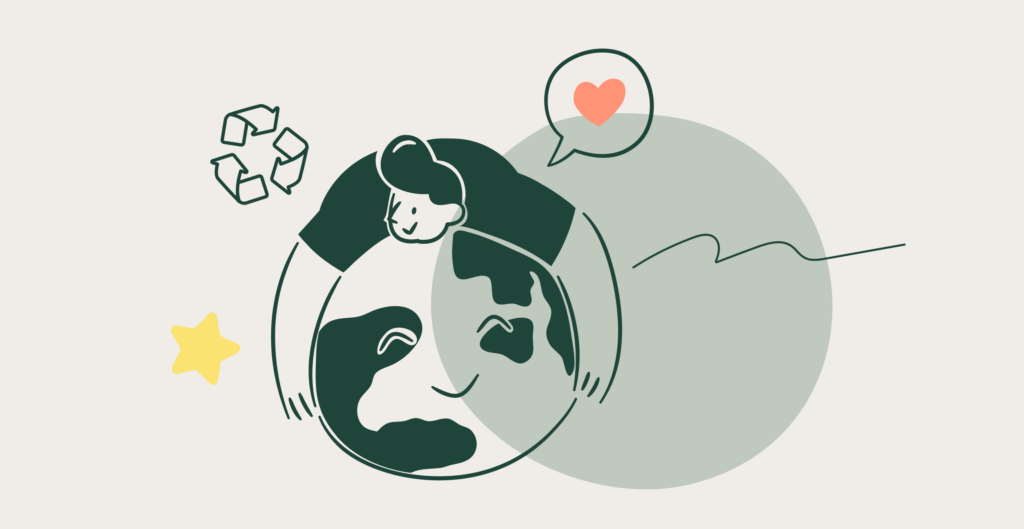Sustainable Change: Environment
Author
Paisley Nyberg
Date
juin 2, 2022

The Sustainable Change series continues with some of our takeaways from the Environment section of the B Impact Assessment, as part of our journey to B Corp!
BLOG: Sustainable Change | Community
Environment
The Environment portion of the BIA covers Plank’s environmental performance through our facilities, materials, emissions, and resource and energy use. As a service company working out of a leased office space, this was the section we felt we were lacking the most. In fact, it was quite humbling. And that’s okay! We recognize that we will never be perfect, but the more aware we are of our practices, the more we can do to keep ourselves accountable and make sustainable improvements.
While Plank’s mission is to make the internet a better place, we are no less committed to doing our part to help the world be a better place by conducting all facets of our business in an environmentally conscious manner. We are constantly re-evaluating our business practices to ensure that our work, actions, and voice as a company reflect our ongoing effort to act more ethically, responsibly, and consciously, with particular attention to the environment.
With recent updates to our employee manual’s environmental policies, here are a few things we’ve done to improve our efforts:
Using environmentally-preferred office supplies whenever possible
As a tech company, we attempt to minimize paper use; however, our pens, inks, and paper supplies are non-toxic and environmentally preferred where possible. Our in-office kitchen supplies consist of non-toxic cleaning products and unbleached paper products. We use ceramic cups, plates and reusable straws in lieu of disposable options and make full pots of coffee in lieu of single-use pod machines. All waste products are recycled whenever possible.
In full transparency, COVID has made some of these practices challenging due to health & safety requirements, sporadic remote work, and just the general uncertainty of it all — however, we have been working back towards these goals and are already making plans to adopt new practices that will only make our environmental impact stronger.
We also attempt to purchase from and work with suppliers who demonstrate a commitment to sustainability, offer long-lasting quality goods, help reduce product waste and support positive social action — we recently put together a list of our favourite sustainable office suppliers that we shared with our team and on our website.
Reducing electronic waste
In order to help combat the global issue of electronic waste, we have put in place a multi-tiered system for products that are being rotated out of use:
- Sell it during the annual “Old Hardware Sale,” an event where other team members will have the option to buy hardware that has been rotated out of use.
- Donations to community groups
Recycled and/or disposed of using one of the many provincial programs
Travelling responsibly
We know that to be a great partner to our clients and partners, there are going to be times that we will need to travel to collaborate in person with non-local teams. On the other hand, our ability to collaborate remotely has certainly increased over the past couple of years.
We have, as a result, decided to commit to the following changes to our travel approach — reduce plane travel by 75%, look toward the lowest impact option for travel, and offset carbon emissions. Each year, we will do a full audit of our carbon footprint to quantify our travel, transit, heating and cooling usage to understand our impact fully. Once calculated, we will pay to offset that impact in our goal to become a zero-emission company.
Optimizing code to lower a website’s carbon footprint
Although it may not be commonly known, the internet consumes a lot of electricity, and in turn produces carbon emissions equal to or greater than the global aviation industry (Source: Website Carbon Calculator). Essentially, every time someone loads a page of your website, there is a small energy impact, which seems negligible at first. But if the code is not optimized and you experience a lot of traffic, the impact builds up quickly. This means that every website we build has its own carbon footprint, and must be accounted for in our process.
As part of our Ethical Web Design Framework, we ensure that all of the websites we build meet specific requirements. We optimize our code and assets to lower a site’s carbon footprint and energy impact. We test using the Website Carbon Calculator to deliver work that is at least 75% cleaner than all sites on the internet. We also recommend to our clients to use a green hosting partner or to pay to carbon offset the site’s annual impact.
Encouraging an Environmentally Friendly Workplace
We may have a lot of work to do to further minimize our environmental impact but we are proud to continue on our path to sustainable change. By continuously asking questions, committing to sustainability research, and encouraging small steps towards a bigger impact we are confident we will reach our goals.
As always, we would love to hear about what actions you or your company have taken to reduce your environmental impact!
Stay tuned for our last blog post in the Sustainable Change series about Customers, which will give you some insight into how our Impact Business Model and day-to-day operations directly empower our clients and their audiences.
